
Quercus douglasii, known as blue oak, is a species of oak endemic to California, common in the Coast Ranges and the foothills of the Sierra Nevada. It is California's most drought-tolerant deciduous oak, and is a dominant species in the blue oak woodland ecosystem. It is occasionally known as mountain oak and iron oak.

Cercocarpus, commonly known as mountain mahogany, is a small genus of at least nine species of nitrogen-fixing flowering plants in the rose family, Rosaceae. They are native to the western United States and northern Mexico, where they grow in chaparral and semidesert habitats and climates, often at high altitudes. Several are found in the California chaparral and woodlands ecoregion.

Peavy Arboretum is an arboretum operated by Oregon State University and located on Arboretum Road, Corvallis, Oregon. It is open to the public daily without charge.
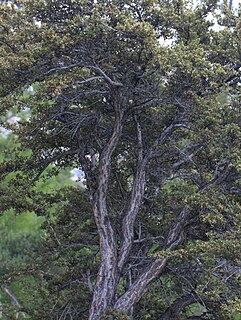
Cercocarpus ledifolius is a North American species of mountain mahogany known by the common name curl-leaf mountain mahogany. It is widespread across much of the Western United States as well as Baja California in Mexico. It can be found at elevations ranging from 600 to 3,000 m elevation, with the preferred altitude varying depending on the region. It prefers shallow, well-drained soils with a sandy or grainy consistency, and is generally found in areas which receive low annual precipitation (15–26 cm). This makes it common on low mountains and slopes, where it grows in scattered groves among other drought-resistant species such as Pinyon Pines, Junipers and Sagebrush ecosystems.

Cercocarpus traskiae, known by the common names Santa Catalina Island mountain-mahogany and Catalina mahogany, is a rare species of plant in the rose family.
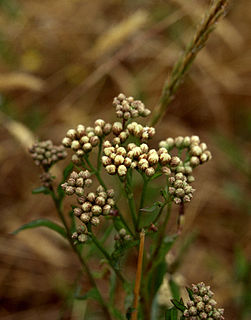
Baccharis glutinosa is a species of flowering plant in the family Asteraceae known by the common names saltmarsh baccharis and Douglas' falsewillow.

Cusickiella is a small genus containing two species of plants in the family Brassicaceae which are native to the western United States. These are mat-forming perennials with a stumpy, branching caudex covered in rounded clusters of tiny, thick leaves. A short stem bears white or yellowish flowers that yield silicles.

Senecio flaccidus, formerly recorded as Senecio douglasii, member of the daisy family and genus Senecio also known as threadleaf ragwort, is a native of the southwestern Great Plains of North America.

Cercocarpus betuloides is a shrub or small tree in the rose family. Its common names include mountain mahogany and birch leaf mountain mahogany The common name "mahogany" comes from the hardness and color of the wood, although the genus is not a true mahogany.

Cercocarpus ledifolius var. intricatus is a variety of Cercocarpus ledifolius that is commonly known as little-leaf mountain mahogany.

Chaenactis douglasii is a North American species of flowering plant in the daisy family known by the common name Douglas' dustymaiden.

Chorizanthe douglasii is a species of flowering plant in the buckwheat family known by the common names San Benito spineflower and Douglas' spineflower. It is endemic to California, where it grows in the mountains of the Southern California Coast Ranges, from the Santa Lucia Range east to the Gabilan Range.

Cirsium douglasii is a species of thistle known by the common names Douglas' thistle and California swamp thistle.

Diplacus douglasii is a species of monkeyflower known by the common names brownies and purple mouse ears. It is native to the mountains and foothills of California and Oregon, where it is often found on serpentine soils. D. douglasii was first described in a published flora by George Bentham, an English botanist who was considered "the premier systematic botanist of the nineteenth century,." It was later described by Asa Gray, the father of North American botany.

Coreopsis douglasii is a species of flowering plant in the family Asteraceae known by the common name Douglas' tickseed. It is native to California from Santa Clara County to San Diego County, as well as from Mohave County in Arizona.
Quercus × alvordiana, the Alvord oak, is a hybrid oak in the genus Quercus. It has been reported to be a hybrid between Quercus douglasii and Quercus turbinella, or between Q. douglasii and Quercus john-tuckeri, which was formerly considered to be a variety of Q. turbinella.
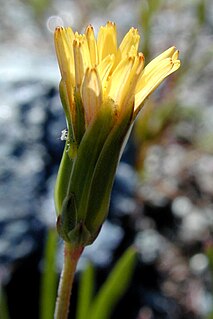
Microseris douglasii is a species of flowering plant in the family Asteraceae known by the common name Douglas' silverpuffs. It is native to western North America from Oregon and California to Baja California. It grows in several types of habitat, including grassland and vernal pools, and on soils containing clay and serpentine.
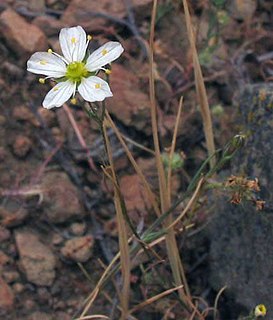
Minuartia douglasii is a species of flowering plant in the family Caryophyllaceae known by the common name Douglas' stitchwort.
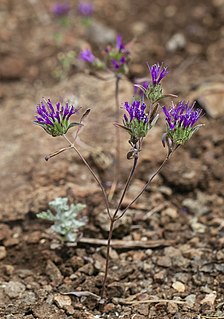
Monardella douglasii is a species of flowering plant in the mint family known by the common name Douglas' monardella.

Silene douglasii is a species of flowering plant in the family Caryophyllaceae known by the common name Douglas's catchfly.


















